Comprehensive Guide to Tank Welding Inspection for Safety and Quality
Comprehensive Guide to Tank Welding Inspection for Safety and Quality
Blog Article
An In-depth Overview of Storage Tank Welding Examination Requirements and Methodologies for Improved Weld High Quality and Performance
The importance of welding inspection criteria in the production of tanks can not be overemphasized, as they serve as the foundation for guaranteeing weld integrity and functional reliability. Various assessment methods, including aesthetic assessments and advanced non-destructive screening approaches, are vital in determining possible defects that might jeopardize efficiency.
Significance of Welding Examination Specifications

Welding evaluation requirements incorporate a variety of requirements, consisting of material specs, welding treatments, and certifications of personnel included in the welding procedure. By enforcing these requirements, organizations can methodically identify and remedy prospective issues, thereby lowering the probability of expensive fixings or devastating failures. In addition, extensive inspection methods foster a culture of liability and precision, urging welders to preserve high degrees of workmanship.

Usual Welding Evaluation Techniques


Ultrasonic Evaluating (UT) is one more prevalent technique, utilizing high-frequency acoustic waves to identify inner imperfections that might not show up externally. This method is particularly effective for recognizing gaps or additions within the weld steel. Magnetic Bit Evaluating (MT) is also extensively made use of, particularly for ferromagnetic materials, as it reveals surface area and near-surface flaws with the application of electromagnetic fields and ferrous fragments.
In Addition, Liquid Penetrant Testing (PT) detects surface-breaking issues by using a penetrant to the weld and then making use of a programmer to extract the penetrant. Each of these techniques adds to an extensive inspection approach, making sure that welds meet the stringent high quality standards called for in storage tank construction.
Governing Criteria and Conformity
Regulative standards and conformity are important parts in making sure the safety and dependability of welded frameworks in tank building - Tank Welding Inspection. These standards offer to establish minimum demands for product homes, welding procedures, and assessment practices, consequently reducing the danger of architectural failures and improving total performance
Trick organizations, such as the American Society of Mechanical Designers (ASME) and the American Welding Culture (AWS), offer standards that are widely embraced in the sector. Compliance with official site these requirements not just ensures adherence to finest techniques but also satisfies lawful and contractual responsibilities, securing the passions of stakeholders.
Regulative bodies frequently mandate adherence to details codes, such as ASME Code Section IX for welding certifications and API 650 for welded tanks. These codes outline needs for welding methods, certifications of personnel, and testing methods to confirm weld stability.
Normal audits and examinations are crucial to preserving compliance, as they assist determine inconsistencies from official website developed criteria. Non-compliance can cause significant penalties, job hold-ups, and security risks. Hence, a robust understanding of regulatory requirements and a commitment to conformity are vital in attaining high-grade and durable bonded container frameworks.
Non-Destructive Examining Approaches
Exactly how can the stability of welded structures be assured without causing damages? Non-destructive screening (NDT) approaches use a robust service, allowing inspectors to evaluate weld top quality without endangering the product - Tank Welding Inspection. Among the most usual NDT strategies are ultrasonic screening (UT), radiographic testing (RT), magnetic particle screening (MT), and color penetrant testing (PT)
Radiographic screening involves passing X-rays or gamma rays via the weld, producing photos that expose structural flaws such as cracks or gaps. This method is very useful for examining the integrity of intricate welds.
Magnetic particle screening is suited for ferromagnetic products, where electromagnetic fields expose surface and near-surface interruptions. Dye penetrant screening utilizes a liquid color to highlight surface-breaking defects, making it a reliable method for non-porous products.
Each of these NDT methods has unique benefits, enabling extensive assessments tailored to specific products and welding processes. By applying these techniques, sectors can guarantee the integrity and safety of bonded structures, ultimately enhancing total efficiency.
Enhancing Weld Quality Through Examination
Reliable assessment plays a critical role in enhancing weld high quality, acting as an essential checkpoint in the fabrication process. By determining prospective issues early, inspections reduce the danger of jeopardized architectural honesty and make certain conformity with industry standards. Employing a combination of visual evaluations, non-destructive testing (NDT) techniques, and mechanical evaluations, examiners can find concerns such as porosity, splits, and insufficient blend.
Applying a durable examination method not just boosts the total top quality of welds yet likewise promotes a culture of responsibility among welders and fabricators. Regular training and certification of inspection personnel ensure that they are outfitted with the essential abilities to acknowledge and attend to prospective issues properly. This aggressive strategy decreases rework and linked expenses, ultimately adding to predict effectiveness.
Additionally, extensive documentation of examination searchings for offers valuable understandings into recurring issues, promoting constant enhancement in welding methods. By leveraging sophisticated innovations, such as automated ultrasonic screening or digital radiography, weld quality can be enhanced through extra specific analyses. In conclusion, a rigorous assessment process is important in achieving top quality welds, making sure security, dependability, and durability in tank manufacture.
Conclusion
In conclusion, the application of extensive container welding inspection requirements and approaches is important for making sure weld honesty and efficiency. By visit their website making use of a mix of aesthetic assessments, non-destructive testing techniques, and adherence to governing standards, companies can properly determine and alleviate potential problems. Cultivating a culture of responsibility amongst welders even more enhances the quality of welding procedures. Eventually, these methods contribute to reduced architectural failures, lower repair service prices, and improved operational effectiveness within the sector.
Report this page